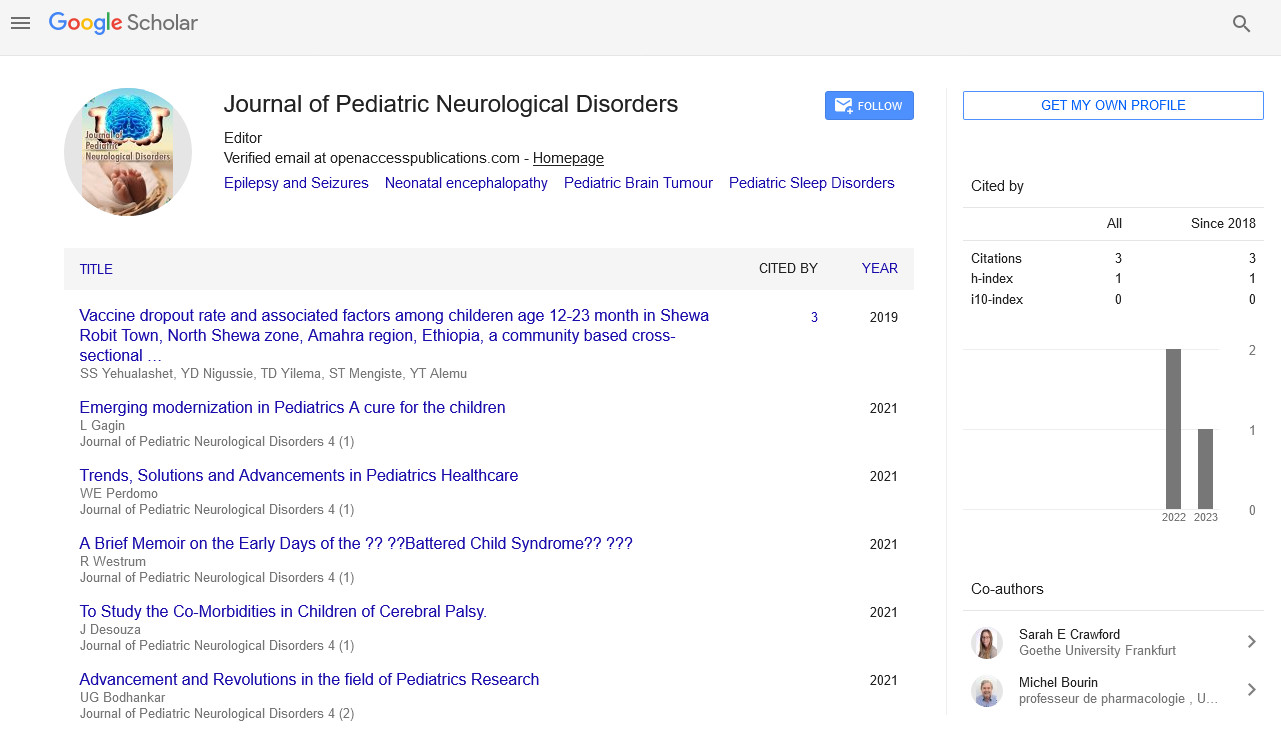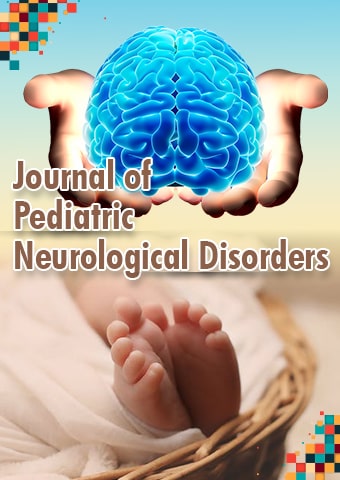Short Article - Journal of Pediatric Neurological Disorders (2019) Volume 2, Issue 2
Neurodevelopmental impairment of Neonatal Meningitis in Full-Term and Near-Term Newborns : A Retrospective Study of One Center
Herve Berenger Chatue Kamga
Hospital Villeneuve saint Georges Paediatrician/ out patient office, Montigny les Cormeilles France.
Abstract
Neonates are at more serioushazard for sepsis and meningitisthandifferentages. EarlyNeonatalmeningitis due to streptococcus group B isserious but uncommondisease.
The prevalence of neonatalmeningitisisestimated 0.15- 0.5per 1000 birth in industrialized countries and mortalityfromneonatalmeningitis ranges from 10–15%.
Increasingntrapartumantibioticprophylaxis(IAP)coveragew aslinearlyassociatedwithdecreasedrisk of Early-onset group B streptococcaldisease (EOGBS) diseaseby 85-90%. But group B Streptococcus (GBS ; Streptococcus agalactiae) still a leadinginfectious cause of neonatalmorbidity and mortality of neonatalonsetsepsis and. Theriskwithoutan IAPpolicyisestimated 1,1%.
Neurologic complications remainshigh in neonate patient withneonatalmeingitis due to streptococcus.
Global eatiology of bacterialmeningitis:
The occurrence of intrusive GBS illness in newbornchildrenwas 0.49 per 1000 live birth (95% certain stretch [CI], .43-.56), and wasmostelevated in Africa (1.12) and least in Asia (0.30). Early-onsetdisease incidence wasp 0.41 (95% CI, .36-.47); latte-onsetdisease incidence wasp 0.26 (95% CI, .21-.30). C. Stéréotype III (61.5%) commande, witz 97% of cases borough about by serotypesIa, Ibb, II, III, and V.
Objective
The aima of thisstudywas to détermine complications and neurodevelopmentalimpairement ofneonatalmeningitis, due to streptococcus group B in full and full Termnewborns in a tertiaire-levelneonate intensive care unit.
Study design
Twenty five (25) cases of neonatalmeningitis B streptococcus Benwee 1985 and 2010 have been reporte. Twowereexcludedbecausetheyhadcongenitalabnomalies. 14 records have not been found in the archives.
Résults
In total, only 9 cases have been analyzed. Eight kids hadeither a CT sweep or MRI and head ultra sound (HUSS). All eighthad an abnormalimaging: 5 cases 62.5% had a stroke, one case of ventricularleukomalaciawashighlighted. OtherAbnormalitieswereasymmetricpericerebraledema, a right temporal cortical subcorticallesions; 1 echogenicity and ventricular dilatation.
All children admitted were symptomatic: neurologicalsymptomswerepresentin 66.66% of cases, breathing in all cases, hemodynamicin 33% of cases.
The median admission wasp 13 days (3-20) age; the mediantemperature of 38.5 of the 9 cases, onlythreemothershad a history streptococcus B 95% CI (0.117-0.64). The average glucose levelwas 1.4 mmol/ l, the proteinlevel of 1.75g /.Blood culture wasp certain in 33.33%, 95% CI (0.11-0.64). 25% hadneurodisabilitiesbetween the ages of 1-4 years.
WBC : white blood count, MRI: MagneticResonance Imaging, CRP: C-réactive Protéine. P: lumbarpuncture CT Scan : X-ray computedtomography.
DISCUSSION
The frequency of beginning stage sepsisbecause of gathering B streptococcus (GBS), 0 • 43 for every 1000 live birth [95% CI 0, 37-0, 49] and mortality 12, 1% is multiple times higherthanthoseannounced for latte contaminations. Intense complexities of neonatalbacterialmeningitisincorporatecerebraledema
(vasogenic and cytotoxic), ventriculitis, cerebritis, hydrocephalus, brainabscess, cerebralinfarction, and subdural effusion or empyema .Development of these complications may lead to lead to moderate to severeneurodisabilities .
UK and IRELAND surveillance : In a retrospective, active national surveillance of invasive group B streptococcaldisease in infants youngerthan 90 dayswasdonefrom April 1, 2014to April 30, 2015, through the British Paediatric Surveillance Unit, microbiologyreferencelaboratories, and national public healthagencies in the UK and Ireland.
In Patterns of complications of neonatal and infant on MRI by organism: A 10 yearreview by Jacob and coll. In a 10 yrretrospectivereview of magneticresonanceimaging (MRI) and microbiology data for all neonates (age<30 d) and infants (age<1 yr) imaged for possible complications of meningitisat a tertiarychildren'shospital. 63 patients (25 neonates, 38 infants) weincluded in the study. The 3 mostcommonpathogenswerestreptococcalspecies (n = 32, meanage 4.7 mo), E. coli (n = 9, mean 1.2 mo), and herpes simplex virus (n = 4). The mostcommonfindingsweremeningealenhancement (78% of thosegiven IV contrast), infarct (52%), subdural collection (35%), and ventriculomegaly (32%).
E. coli presentedmuch more frequentlywithventriculomegaly (64% vs. 22%) thanstreptococcalspecies. Extensive infarctsweretypical of streptococcalmeningitis (13/32, 41%) and rarelyseenwithotherorganisms (2/31, 6%, p = 0.001).
In study of brainMagneticResonance Imaging of Infants withBacterialMeningitis, by Carlos R. Oliveira and coll. 440 infants lowerthan 12 mothswhohadmeningitiswereenrolled . Of these, 68% (75/111) had a brain MRI performedduring the hospitalization; abnormalitiesincludedleptomeningealenhancement (57%),cerebralinfarct (43%), subduralempyema (52%), cerebritis (26%), hydrocephalus (20%), and abscess (11%).
Rajesh Gupta and coll.reported a 2-day-old infant presentedBilateralhaemorrhagic basal gangliainfarctionassociatedwithearly-onset group B streptococcus. MRI brainshowed extensive haemorrhagicinfarctionwithin the lentiform and caudatenucleiwithinvolvement of bothposteriorlimbs of the internal capsule .Haemorraghewasfollowed by triventricularhydrocephalus ,complicated by infantile spasms, and neurodevelopmentimpairment : cerebralpalsy. A systematicreview and meta-analysis of impact in intelligence and developmentwereperformed by DebarhCristie.Theyfoundedmoderateevidencethatsurvivin gbacterialmeningitis has a deleterious impact on IQ and development in infant.
Thirtytreestudiesprovided data on intelligence quotient( IQ )(2015 subjects) and 12 on developmentaldelay (382 subjects). Across all bacterialorganisms, meningitissurvivorshad a mean IQ 5.50 (95% CI: -7.19, - 3.80; I2 = 47%, p = 0.02) points lowerthancontrols.
IQ wassignificantlylowerthancontrols for Neisseriameningitides (NM: 5 points) and Haemophilus influenzae b (Hib: 6 points) but not in viral, withonly single studiesincluded for Streptococcus pneumoniae (SP) and group B streptococcus (GBS).
In NeurodevelopmentalImpairment in ChildrenAfter Group B StreptococcalDiseaseWorldwide: SystematicReview and Meta-analyses :MayaKohli-Lynch and all estimate of moderate to severeNeurodevelopmentalimpairment (NDI )following GBS meningitisin 18% (95% CI, 13%–22%) of survivors.Is consistent witz the estimate of NDI aftermeningitis of all infectiousetiologies, whichis 23% (95% CI, 19%–26%).
Conclusion:
Neonatalmeningitis due to groupe B streptococcus isuncommon, howevercan cause inconvenience in bothterm and preterm infant. Neurologicoutcomeremains the major adverse outcome of survivors.
In ourstudy the main acute neuro-imaging complication is stroke ; witz 25 per cent of neurologicdisabilitiesat four yearold.
All neonatalmeningitisshould have clause neurodevelopmentalfollow up due potentialneurodisabilities.
Bibliography :
1. P T Heath et al. NeonatalmeningitisArch Dis Child FetalNeonatal Ed 2003; 88:F173-F178
2. Stoll B, Hansen N, Sánchez P et al for the Eunice Kennedy Shriver National Institute of Child Health and HumanDevelopmentNeonatalResearch ,Network. Earlyonsetneonatalsepsis: The burden of group B Streptococcal and E.colidisease continues. Pediatrics 2011; 127 (5): 817–826
3. Edmond KM, Kortsalioudaki C, Scott S, et al. Group B streptococcaldisease in infants agedyoungerthan 3 months: systematicreview and meta-analysis. The Lancet. 2012; 6736(11):61651-6.
4. 11. Marcus C. Hermansen,MaryGoetzHermansen. Perinatal Infections and CerebralPalsy. Clin Perinatol 2006; 33: 315– 333.
5.Volpe JJ. Bacterial and fungalintracranial infections. In: Neurology of the newborn, 4th ed, WB SaundersCompany, Philadelphia 2001. p.774.
6.PLoS One. 2018 Jun 11;13(6):e0198772. doi: 10.1371/journal.pone.0198772. eCollection 2018.
Global etiology of bacterialmeningitis: A systematicreview and meta-analysis.Oordt-Speets AM1, Bolijn R1, van Hoorn RC1, Bhavsar A2, Kyaw MH3.
7. Jacob L.JaremkoAnnaS.MoonSurekhaKumbla, Patterns of complications of neonatal and infant on MRI by organism: A 10 yearreview. European Journal of Radiology ,Volume 80, Issue 3, December 2011, Pages 821-827
8.MayaKohli-Lynch et al.NeurodevelopmentalImpairment in ChildrenAfter Group B StreptococcalDiseaseWorldwide: SystematicReview and Meta-analyses, Bilateral . Clin Infect Dis. 2017 Nov 15; 65(Suppl 2): S190–S199.
9. Rajesh Gupta, TaiwoMaraiyesa, BrendonConry;haemorrhagic basal gangliainfarctionassociatedwithearly-onset group B streptococcus meningitis.BMJ Case Rep. 2018 ;2018 : bcr2017223085.
10. Deborah Christie,1Harunor Rashid… : Impact of on intelligence and development: A systematicreview and meta-analysis.PLoS One. 2017 ; 12(8).
11.NajRusseletal.Risk of Early-OnsetNeonatal Group B StreptococcalDiseaseWithMaternalColonizationWorldwid e: SystematicReview and Meta-analyses ,clin Infect Dis. 2017 Nov6 ;65(suppl_2):S152-S159.
12 GuduruGopal Rao and call. Early-onset group B Streptococcus (EOGBS) infection subsequent to cessation of screening-basedintrapartumprophylaxis: findings of an observationalstudy in West London, UK.BMJ Open. 2017 ; 7(11): e018795.
13.Carlos R. Oliveira and coll.BrainMagneticResonance Imaging of Infants witz Bacterial. J Pediatr. 2014 Jul;165(1):134-9.
This work is partially presented at 2nd International Conference on Pediatrics and PediatricsHealthcare, Dubai, UAE, September 24-25, 2020.

